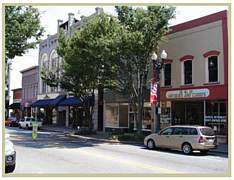Concord, North Carolina
| Concord, North Carolina | ||
|---|---|---|
| Satellite city | ||
| City of Concord | ||
|
Downtown Concord | ||
| ||
| Motto: "High Performance Living" | ||
 Location of Concord within North Carolina | ||
| Coordinates: 35°24′16″N 80°36′2″W / 35.40444°N 80.60056°WCoordinates: 35°24′16″N 80°36′2″W / 35.40444°N 80.60056°W | ||
| Country |
| |
| State | North Carolina | |
| County | Cabarrus | |
| Founded | April 1796 | |
| Incorporated | 1806 | |
| Government | ||
| • Type | Council - Manager | |
| • Mayor | Scott Padgett | |
| Area | ||
| • Satellite city | 60.30 sq mi (156.18 km2) | |
| • Land | 60.27 sq mi (156.09 km2) | |
| • Water | 0.03 sq mi (0.09 km2) 0.06% | |
| Elevation | 706 ft (215 m) | |
| Population (2014 est.[1]) | ||
| • Satellite city | 85,560 | |
| • Density | 1,418.9/sq mi (547.8/km2) | |
| • Metro | 2,380,314 | |
| Time zone | EST (UTC-5) | |
| • Summer (DST) | EDT (UTC-4) | |
| ZIP code | 28025, 28026, 28027 | |
| Area code(s) | 704, 980 | |
| FIPS code | 37-14100[2] | |
| GNIS feature ID | 0983424[3] | |
| Website |
www | |
Concord (kon-kord) is a city in Cabarrus county, in the U.S. state of North Carolina. As of the 2010 census, the city had a population of 79,066,[4] with an estimated population in 2015 of over 85,000.[5] It is the county seat and the largest city in Cabarrus County.[6] In terms of population, the city of Concord is the second-largest city in the Charlotte Metropolitan Area and is the twelfth largest city in North Carolina.[7]
In 2015, Concord was ranked as the city with the 16th fastest growing economy in the United States.[8]
The city was a winner of the All-America City Award in 2004. Located near the center of Cabarrus County in the Piedmont region, it is 20 miles (32 km) northeast of Charlotte center city.
Concord is the home to some of North Carolina's top tourist destinations, including NASCAR's Charlotte Motor Speedway and Concord Mills.
History
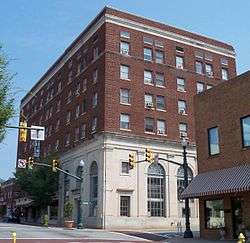
Concord, located in today's rapidly growing northeast quadrant of the Charlotte metropolitan area, was first settled about 1750 by German and Scots-Irish immigrants. The name Concord means with harmony. This name was chosen after a lengthy dispute over where the county seat should be located between the German Lutherans and Scotch-Irish Presbyterians. By United States standards, Concord is considered an old town, as it was incorporated in 1806. Today, markers identifying the original town limits can be seen in the downtown area.
As county seat, Concord became a center of trade and retail for the cotton-producing region, especially on court days. The downtown would be crowded with farmers and townfolk, in addition to lawyers and their clients. During the antebellum era, wealthy was built by planters through the cultivation of cotton as a commodity crop; the work was done by enslaved African Americans.
Located in the Piedmont, Concord became a site of industrialization with cotton mills in the late 19th century. Among the owners of the new mills in the area were men of the rising black middle-class in Wilmington, North Carolina, such as W. C. Coleman, John C. Dancy (appointed as collector of customs at the port), and others, who organized Coleman Manufacturing Company in 1897. They built and operated what is believed to have been the first cotton mill owned by blacks in the nation.[9] They hoped to promote economic security for people of color. But the Wilmington Insurrection of 1898, with white attacks on black areas of the city, caused many deaths, as well as destroying homes and businesses built by blacks since the Civil War. In 1900, Dancy was among more than 2000 blacks who left the city permanently after the riot. He moved to Washington, DC, appointed as the federal Recorder of Deeds, and serving until 1910.[10] The mill operated under black ownership through 1904, hitting difficult times after Coleman died. The brick mill building was later taken over by Fieldcrest Cannon.
Based on wealth from cotton as a commodity crop and through textile manufacturing, Concord's white planters and business owners built some significant homes in the late nineteenth and early twentieth centuries; they range along North and South Union Street and Edgewood Avenue.[11] Within the North Union Historic District is Memorial Garden. Located on 3 acres (12,000 m2), the garden winds through the 200-year-old cemetery of the First Presbyterian Church.
In addition to the Cabarrus County Courthouse, the Barber-Scotia College, Boger-Hartsell Farm, McCurdy Log House, Mill Hill, North Union Street Historic District, Odell-Locke-Randolph Cotton Mill, Reed Gold Mine, South Union Street Courthouse and Commercial Historic District, South Union Street Historic District, Spears House, Stonewall Jackson Training School Historic District, and Union Street North-Cabarrus Avenue Commercial Historic District are listed on the National Register of Historic Places.[12]
From the time of incorporation in the late 1700s through the 1970s, Concord's jurisdiction was centered around the downtown area. Since then, most annexations have taken place west of the center-city area towards Charlotte.[13] Portions of the city limit boundary adjoin the Cabarrus/Mecklenburg County line.
Geography and climate
Concord is located in western Cabarrus County at 35°24′16″N 80°36′2″W / 35.40444°N 80.60056°W (35.404340, -80.600474).[14]
The city is located in the Piedmont area of North Carolina, which is characterized by rolling hills and forest. Land left untended will typically return to native forest land within a few years. The climate can be described as cool winter seasons with hot, humid summer seasons. The average high temperature in the winter is 43 °F (6 °C), and the average daily low temperature is 29 °F (−2 °C). In the summer the average temperature is 79 °F (26 °C), and the average daily high temperature is 88 °F (31 °C).[15] It is not unusual for summer daytime temperatures to reach in the mid to upper 90s and occasionally exceed 100 °F (38 °C). It is typical for winter temperatures to fall into the teens at night, but temperatures generally warm to above freezing during the day. Summer months are characterized as having cool to warm nights with very warm to hot temperatures during the day. The area receives a generous amount of rainfall at 43.8 inches (1,110 mm) per year, with February and April being the two driest months. Rainfall in the winter is lighter but more frequent, whereas rainfall in the summer is heavier but less frequent. Thunderstorms, both light and strong, are common in the spring and summer months. The sun shines 70 percent of the time in summer and 55 percent in winter. The prevailing wind is from the southwest, with the average highest windspeed of 9 miles per hour (14 km/h) in spring.[15]
The city has a total area of 60.3 square miles (156.2 km2), of which 0.04 square miles (0.1 km2), or 0.06%, is water. The elevation at the center of downtown is 706 feet (215 m) above sea level.
Concord is located northeast of Charlotte, the largest city in North Carolina. Concord is the second-largest city in the Charlotte Metropolitan Area. It is positioned about half-way between Charlotte and Salisbury. Several other smaller cities and towns are located close to Concord, including Kannapolis, China Grove, Landis, Mount Pleasant, Harrisburg, Midland, and Locust.
Demographics
| Historical population | |||
|---|---|---|---|
| Census | Pop. | %± | |
| 1870 | 878 | — | |
| 1880 | 1,264 | 44.0% | |
| 1890 | 4,339 | 243.3% | |
| 1900 | 7,910 | 82.3% | |
| 1910 | 8,715 | 10.2% | |
| 1920 | 9,903 | 13.6% | |
| 1930 | 11,820 | 19.4% | |
| 1940 | 15,572 | 31.7% | |
| 1950 | 16,486 | 5.9% | |
| 1960 | 17,799 | 8.0% | |
| 1970 | 18,464 | 3.7% | |
| 1980 | 16,942 | −8.2% | |
| 1990 | 27,347 | 61.4% | |
| 2000 | 55,977 | 104.7% | |
| 2010 | 79,066 | 41.2% | |
| Est. 2015 | 87,696 | [16] | 10.9% |
Census 2010
According to the 2010 Census, Concord's population is 79,066.[4] Of those persons claiming to be of one race, the racial breakdown is 70.4% white, 17.8% black or African American, 2.6% Asian, 0.3% Native American, 0.1% Pacific islander, 6.4% of other races. Persons of two or more races is 2.3%. Persons belonging to the Hispanic or Latino race are 12.3%. There are 32,130 housing units in Concord. Of those housing units, 90.7% are occupied, and 9.3% are vacant. Additional detailed and summary data from the Census 2010 is not yet available.
Census 2000

The census[2] of 2000 determined there were 55,977 people, 20,962 households, and 14,987 families residing in the city. The population density was 1,085.3 people per square mile (419.0/km²). There were 22,485 housing units at an average density of 435.9 per square mile (168.3/km²). The racial makeup of the city was 78.83% White, 15.10% African American, 0.30% Native American, 1.22% Asian, 0.03% Pacific Islander, 3.35% from other races, and 1.18% from two or more races. Hispanic or Latino of any race were 7.80% of the population.
In 2000, there were 20,962 households out of which 35.2% had children under the age of 18 living with them, 55.7% were married couples living together, 11.5% had a female householder with no husband present, and 28.5% were non-families. 23.6% of all households were made up of individuals and 8.0% had someone living alone who was 65 years of age or older. The average household size was 2.61 and the average family size was 3.08.
In 2000, the city the population was spread out with 26.2% under the age of 18, 8.9% from 18 to 24, 33.6% from 25 to 44, 20.2% from 45 to 64, and 11.1% who were 65 years of age or older. The median age was 34 years. For every 100 females there were 95.5 males. For every 100 females age 18 and over, there were 92.8 males.
Also in 2000, the median income for a household in the city was $46,094, and the median income for a family was $53,571. Males had a median income of $37,030 versus $26,044 for females. The per capita income for the city was $21,523. About 5.8% of families and 8.2% of the population were below the poverty line, including 10.0% of those under age 18 and 12.7% of those age 65 or over.
Religion
The earliest settlers were mainly immigrants, German Lutherans and German Reformed Protestants, and Scots or Scotch Irish Presbyterians, who began settling in Cabarrus County in the 1750s. In 1773 the Zion (Organ) Church community and the St. Johns Church community of about sixty families commissioned two men, Christopher Rintelmann from Zion Church and Christopher Lyerly from St. Johns Church to travel to London to seek permission from King George III to acquire a preacher (and a schoolteacher) from Hanover, Germany. Adolphus Nussmann was chosen by the Consistory of Hanover to answer the call and became the first Lutheran preacher in North Carolina. He served five churches from Salisbury to Concord, and subsequently planted twenty congregations and five schools in the greater Concord, Cabarrus, and Rowan county areas.[18]
Today the county has wide religious diversity, as well as strong overall religious affiliation rates. According to the 2000 Religion Report, more than 63% of area residents are affiliated with a local religious body .[19] Concord is home to many churches and a Jewish congregation, Temple Or Olam.
Economy
Concord has a diverse economy comprising shipping and transportation, banking, manufacturing, motorsports, and various service sectors.
Employers
Concord has many small businesses but also has several large employers such as Carolinas Healthcare System, Cabarrus County Schools, Shoe Show, Inc., Celgard LLC, Connextions, Roush Fenway Racing, Sysco Foods, S&D Coffee, and is home to the international headquarters for ACN Inc..
According to the city's 2014 Comprehensive Annual Financial Report,[20] the top employers in the city are:
| # | Employer | # of Employees |
|---|---|---|
| 1 | Carolina Medical Center-NorthEast | 4,500 |
| 2 | Cabarrus County Schools | 3,800 |
| 3 | Cabarrus County Government | 950 |
| 4 | City of Concord | 901 |
| 5 | Connextions | 900 |
| 6 | Shoe Show | 800 |
| 7 | North Carolina Government | 770 |
| 8 | Kannapolis City Schools | 750 |
| 9 | S&D Coffee and Tea | 625 |
| 10 | Sysco | 510 |
Commerce
Downtown shopping features merchants offering antiques, fine collectibles, and arts and crafts. Concord is also home to the large retail venue Concord Mills, and Charlotte Motor Speedway. These two are the primary economic driving forces of the city.
Motorsports
Concord is the home to Charlotte Motor Speedway, a NASCAR Research and Development Office (which also is the headquarters for research for touring and sportscar racing operations), and several professional race teams, including Hendrick Motorsports, Roush Fenway Racing, Richard Petty Motorsports, and Earnhardt Ganassi Racing. The speedway opened in 1959 by owner Bruton Smith, who is a native of Oakboro, North Carolina. Smith's company, Speedway Motorsports, Inc., owns Charlotte Motor Speedway. The company also owns and operates a dragstrip and dirt track facility adjacent to the speedway. Concord is also home to Windshear, Inc., a firm that owns a state-of-the-art wind tunnel facility used to test the aerodynamics of vehicles (mostly motorsports vehicles).[21]
Government
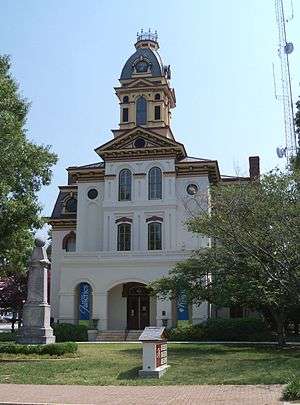
Concord has a council-manager form of government. The mayor and city council are elected every two years, with no term limits. As a single body, the city council holds most of the power in the city government. For example, they have the power to pass ordinances, make resolutions, adopt plans, and establish the budget for the city. The mayor is ex officio chairman of the city council, and only votes in case of a tie. In addition to leadership roles, the mayor represents the city at special events and public appearances. The council appoints a professional city manager to manage and implement the decisions of the city council. In general, the municipal government structure consists of the mayor, seven city council members, and the appointed city manager. The current mayor of Concord is J. Scott Padgett, and the current city manager is W. Brian Hiatt. Padgett was first elected as mayor in 2001 and has been re-elected since.[22] Hiatt has served as Concord's city manager since 1998.[23]
The Concord city government offers a variety of services to its citizens. Six are required by North Carolina General Statute - fire, police,[24] solid waste, street maintenance, water, and wastewater. Additional services that the city offers are electrical distribution, parks and recreation, stormwater system, transportation (streets maintenance and planning), economic development, planning and zoning, community development programs, environmental protection, a transit system, and operation of a regional airport. The operating budget for fiscal year 2012 totaled $207,724,003.[25] The government generates its revenue from sources such as real property tax, sales tax distributions from the State, water and wastewater service fees, electrical utility fees, business privilege licenses, federal or state grants, investments, and other fees (such as parks and recreation, aviation, zoning, etc.).[25] The revenues are distributed back to the community in the form of services.
Historic Courthouse
The Cabarrus County Courthouse was completed in 1876. A 16-foot (4.9 m) marble Civil War monument, dedicated in 1892, is located on the front lawn. The courthouse was recognized for its significance and listed in 1974 on the National Register of Historic Places.[26]
Education
Educational opportunities include public and private schools in elementary, secondary, and higher education. Publicly, the area in Concord is served by the Cabarrus County Schools system.[27] There are 12 elementary schools in Concord, along with 4 middle schools, and 5 high schools. Local private schools include Cannon School and Concord First Assembly Academy
Higher education
Neighborhoods and recreation
In 2000, Concord's city council implemented the "Partnerships for Stronger Neighborhoods" program. This program is designed to enhance the lives of residents in the neighborhoods in the city, increasing the quality of both life and events for those calling Concord home. As part of the program, some city staff members have volunteered to be appointed as liaisons to work directly with neighborhoods that participate in the program. Through this effort, strong communication is established between city government and its citizens. There are currently 45 neighborhoods participating in the program, which contributes to making Concord one of the most sought-after communities for homebuyers in the regional real estate market. Choices are diverse, offering modest homes to multimillion-dollar estates.
The City of Concord provides its neighborhoods with three recreational centers, eight parks, four sport complexes, an aquatics center featuring open swimming and swim lessons, beautiful Lake Fisher, with 3 miles (4.8 km) of lakefront and 534 acres (2.16 km2) providing leisurely boating, fishing, greenways and bike paths. There is also the championship 18-hole Rocky River Golf Club (a Dan Maples design) owned and operated by the City and managed by a contracted company.
Private recreational opportunities are available, including the West Cabarrus YMCA and the Sportscenter. The West Cabarrus YMCA opened in fall 2003. The Sportscenter is a privately owned athletic and recreational facility.
Transportation
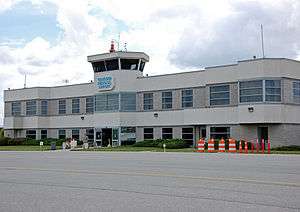
Highways
Interstate 85 links Concord directly to Greensboro and Durham to the northeast and Charlotte, Greenville, and Atlanta to the southwest. Interstate 85 is being widened to eight lanes (four northbound, four southbound) through the city, with construction advancing from south to north. Interstate 485 is located southwest of Concord and parallels the Cabarrus - Mecklenburg County line for several miles, providing access to the Charlotte area. US Highway 29 and US Highway 601 travel through Concord en route to other parts of the Carolinas. US 29 serves as an alternative to Interstate 85 for much of the distance between Charlotte and Greensboro.
Bus
Concord has a local bus system known as CKRider that provides service to Concord and Kannapolis. The system also links to Charlotte Area Transit System (CATS) via an express service as well as at regular service connection points. Greyhound also serves the area.
Rail
There is one railroad line that runs through Concord. It is owned by North Carolina Railroad. There are several industrial facilities served by this railroad line. There are no passenger stations located in Concord, but Amtrak has stations located in the adjacent cities of Kannapolis and Charlotte.
Air
Concord Regional Airport (JQF) is an airport publicly owned and operated by the City of Concord.[28] It is designated as a reliever facility for Charlotte Douglas International Airport (CLT). Charlotte Douglas provides Concord with a major domestic/international gateway. Concord Regional Airport aviation activity consist of charter aircraft, limited commercial flights, flight schools, and private aircraft. The types of aircraft using the facility range from Cessna 150, to Beech Bonanza, to Grumman Gulfstream IV, to Boeing 737-300.[28]
Nearby attractions
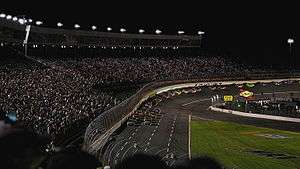
Concord is home to several notable attractions. This includes two malls, a museum, a family resort, a NASCAR track, and an arena and events center that can be used for multiple purposes for the entire county.
- Cabarrus Arena & Events Center
- Carolina Mall[29]
- Carolina Renaissance Festival
- Charlotte Motor Speedway
- Concord Mills
- Concord Speedway (in Midland town limits)
- Great Wolf Lodge
- Reed Gold Mine
- zMax Dragway
Sister cities
Concord has three sister cities, as designated by Sister Cities International:[30]
Notable people
- The Avett Brothers (Scott and Seth Avett, bluegrass-rock musicians)
- Clayton Spencer, 8th President of Bates College
- Carol Barbee, television and movie actor, writer, and producer; now lives in Los Angeles
- Jay Graham, collegiate and NFL football running back, now assistant coach Florida State University
- Jody Hill, film director, screenwriter, producer, actor
- Nikita Koloff, retired WCW professional wrestler
- Gaston Bullock Means, political figure, detective, part of Harding administration's "Ohio Gang"
- Jessica Moore, KSNV anchor and reporter
- Mike Morton, retired NFL linebacker
- Israel Pickens, third governor of the state of Alabama and North Carolina congressman
- Robert D. Raiford, radio personality John Boy and Billy big show
- Rachel Reilly, reality television personality (Winner of Big Brother 13)
- Silda Wall Spitzer, First Lady of New York from January 2007 until March 2008
- Daniel Truhitte,Played Rolfe from The Sound of Music
- Skeet Ulrich
- Ish Smith ,NBA players for the Philadelphia 76ers
- Kyle Seager, Professional baseball player for the Seattle Mariners
- Corey Seager, Professional baseball player for the Los Angeles Dodgers
- Joshua Boger, founder and CEO (retired), Vertex Pharmaceuticals Incorporated (NASDAQ: VRTX), S&P 500 company
See also
Footnotes
- ↑ "US Census Bureau". Census.gov. Retrieved June 5, 2015. Enter Concord, NC for population statistics
- 1 2 "American FactFinder". United States Census Bureau. Archived from the original on 2013-09-11. Retrieved 2008-01-31.
- ↑ "US Board on Geographic Names". United States Geological Survey. 2007-10-25. Retrieved 2008-01-31.
- 1 2 Census 2010
- ↑ "Annual Estimates of the Resident Population for Incorporated Places of 50,000 or More, Ranked by July 1, 2013 Population: April 1, 2010 to July 1, 2013 (PEPANNRES)". U.S. Census Bureau American Factfinder. Retrieved December 17, 2014.
- ↑ "Find a County". National Association of Counties. Archived from the original on 2011-05-31. Retrieved 2011-06-07.
- ↑ NC State Demographer
- ↑ "2015's Cities with the Fastest Growing Economies". WalletHub. Retrieved 2016-08-19.
- ↑ Edmonds, Helen G. The Negro and Fusion Politics in North Carolina, 1894-1901 (1951/reprint 2013) pp 89-92. Quote, p. 92: Dancy wrote: "This is the first genuine cotton mill yet built and controlled by colored men in the history of the country. It stands two miles from Concord, North Carolina, in the midst of a plot of about 140 acres of fertile soil. ...There is no good reason why there should not be a splendid town there governed by ourselves in the near future."
- ↑ Edmonds (1951/2013), "The Negro and Fusion Politics," p. 92
- ↑ Historic District Handbook
- ↑ National Park Service (2010-07-09). "National Register Information System". National Register of Historic Places. National Park Service.
- ↑ City of Concord Planning Department
- ↑ "US Gazetteer files: 2010, 2000, and 1990". United States Census Bureau. 2011-02-12. Retrieved 2011-04-23.
- 1 2 U.S. Dept of Agriculture
- ↑ "Annual Estimates of the Resident Population for Incorporated Places: April 1, 2010 to July 1, 2015". Retrieved July 2, 2016.
- ↑ "Census of Population and Housing". Census.gov. Archived from the original on May 11, 2015. Retrieved June 4, 2015.
- ↑ Foundations of Lutheranism in North Carolina, North Carolina Synod of the Lutheran Church in America, 1966
- ↑ Association of Religious Data Archives
- ↑ "City of Concord CAFR" (PDF). Retrieved 2015-06-05.
- ↑ Windshear
- ↑ Message from the Mayor
- ↑ W. Brian Hiatt, City Manager, City of Concord
- ↑ Police Chief
- 1 2 City of Concord Budget
- ↑ Historic courthouse Retrieved 2014-08-19
- ↑ Cabarrus County School System
- 1 2 Concord Regional Airport Master Plan
- ↑ "Directions". Carolina Mall. Retrieved September 14, 2012.
- ↑ "Interactive City Directory". Sister Cities International. Retrieved 4 June 2015.
- ↑ "Concord has new Sister City in Siena, Italy". The Independent Tribune. Retrieved 2016-05-12.
Further reading
- Bernard Davis, Jr., Portraits of the African-American Experience in Concord-Cabarrus, North Carolina 1860-2008. n.c.: Xlibris, 2010.
- Michael Eury, Concord. Charleston, SC: Arcadia Pub., 2011.
- Gary R. Freeze, Master Mill Man: John Milton Odell and Industrial Development in Concord, North Carolina, 1877-1907. M.A. thesis. University of North Carolina, 1980.
- Gary R. Freeze, "Patriarchy Lost: The Preconditions for Paternalism in the Odell Cotton Mills of North Carolina, 1882-1900," in Gary M. Fink and Merl E. Reed (eds.), Race, Class, and Community in Southern Labor History. Tuscaloosa, AL: University of Alabama Press, 1994; pp. 27–40.
- Barbara Shepherd Garrison, A History of the Concord Public Library of Concord, North Carolina. Chapel Hill, NC: n.p., 1965.
- Clarence E Horton and Kathryn L Bridges, Abstracts from Early Newspapers Published in Concord, North Carolina: 1855-1862. Concord, NC: Cabarrus Genealogy Society, 2002.
- C.L. Hunter, Sketches of Western North Carolina, Historical and Biographical: Illustrating Principally the Revolutionary Period of Mecklenburg, Rowan, Lincoln, and Adjoining Counties, Accompanied with Miscellaneous Information, Much of It Never before Published. Raleigh, NC: Raleigh News Steam, 1877.
External links
| Wikimedia Commons has media related to Concord, North Carolina. |
| Wikisource has the text of a 1911 Encyclopædia Britannica article about Concord, North Carolina. |
 Concord, North Carolina travel guide from Wikivoyage
Concord, North Carolina travel guide from Wikivoyage- City of Concord official website
- Cabarrus County Convention & Visitors Bureau
- Cabarrus Economic Development Corporation
- Cabarrus County Government
 |
Davidson | Kannapolis |  | |
| Huntersville | |
Mount Pleasant | ||
| ||||
| | ||||
| Charlotte | Harrisburg | Midland |
